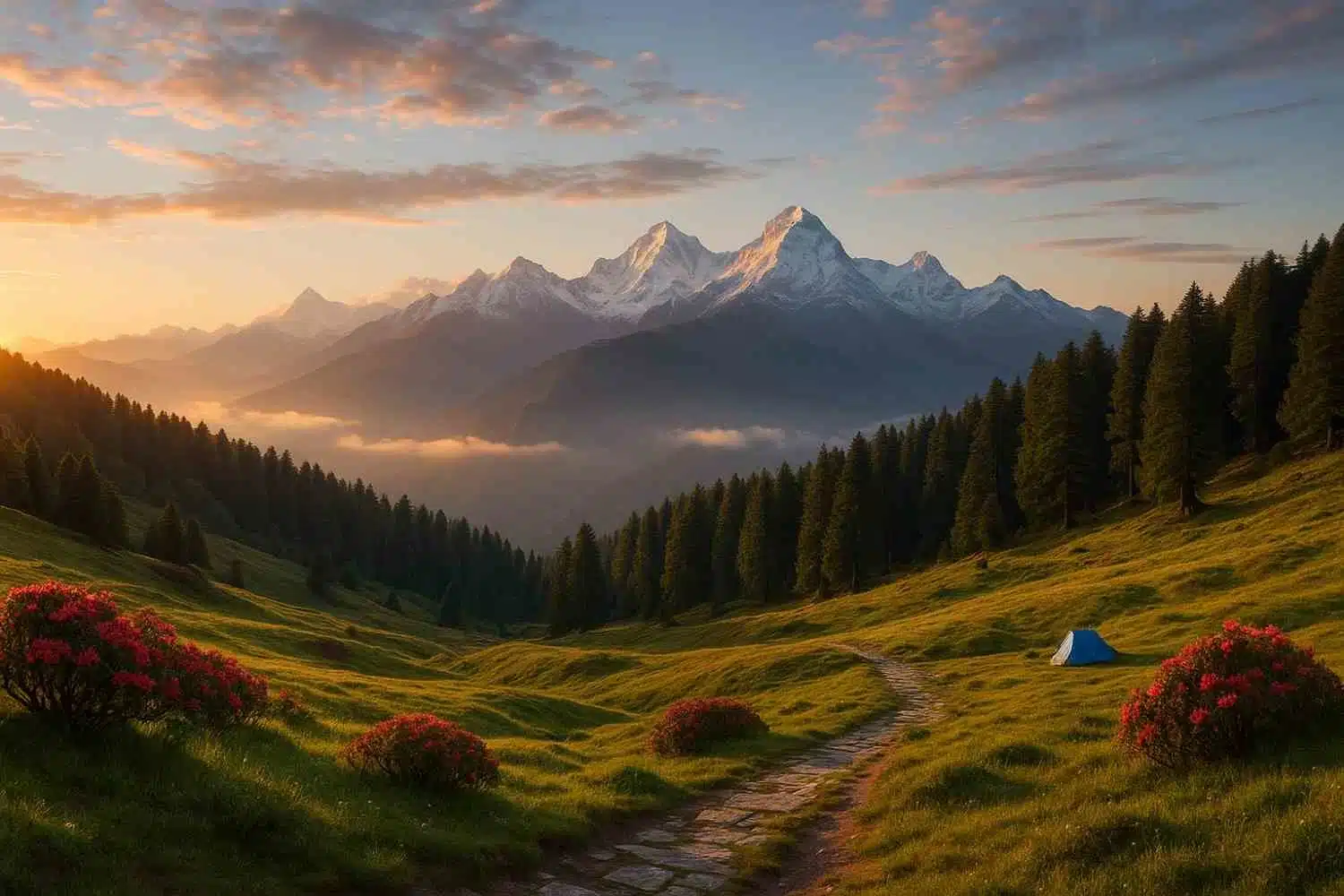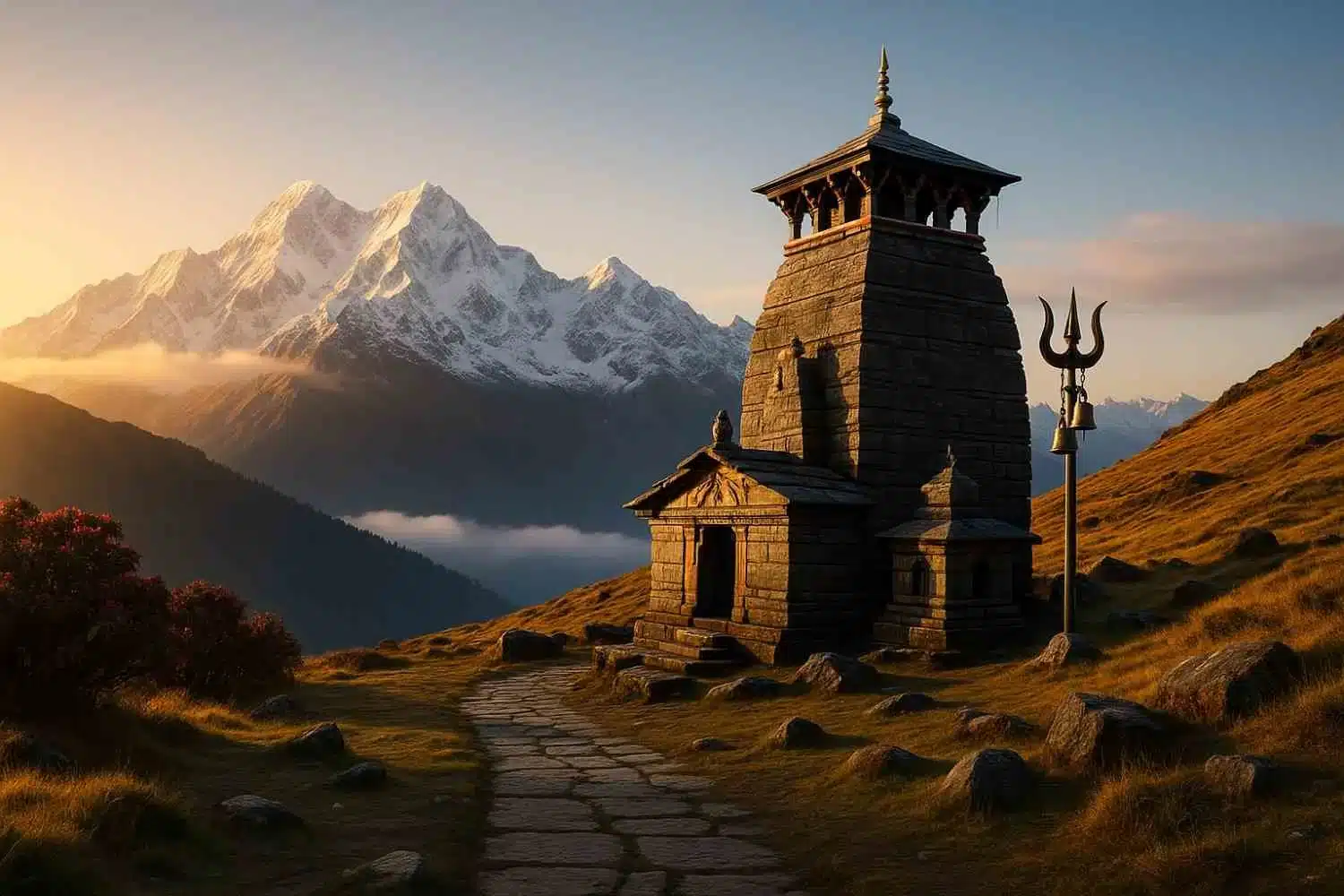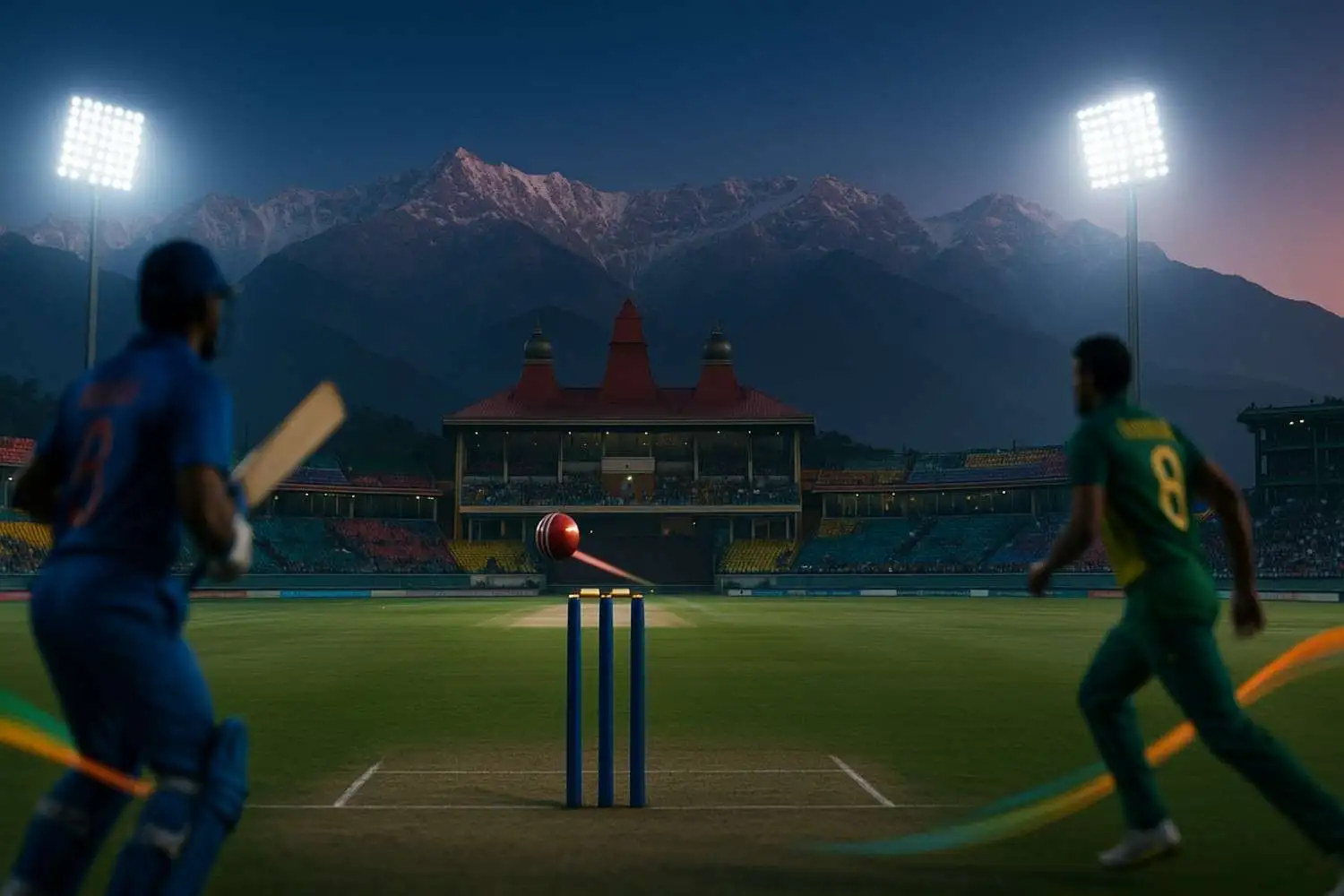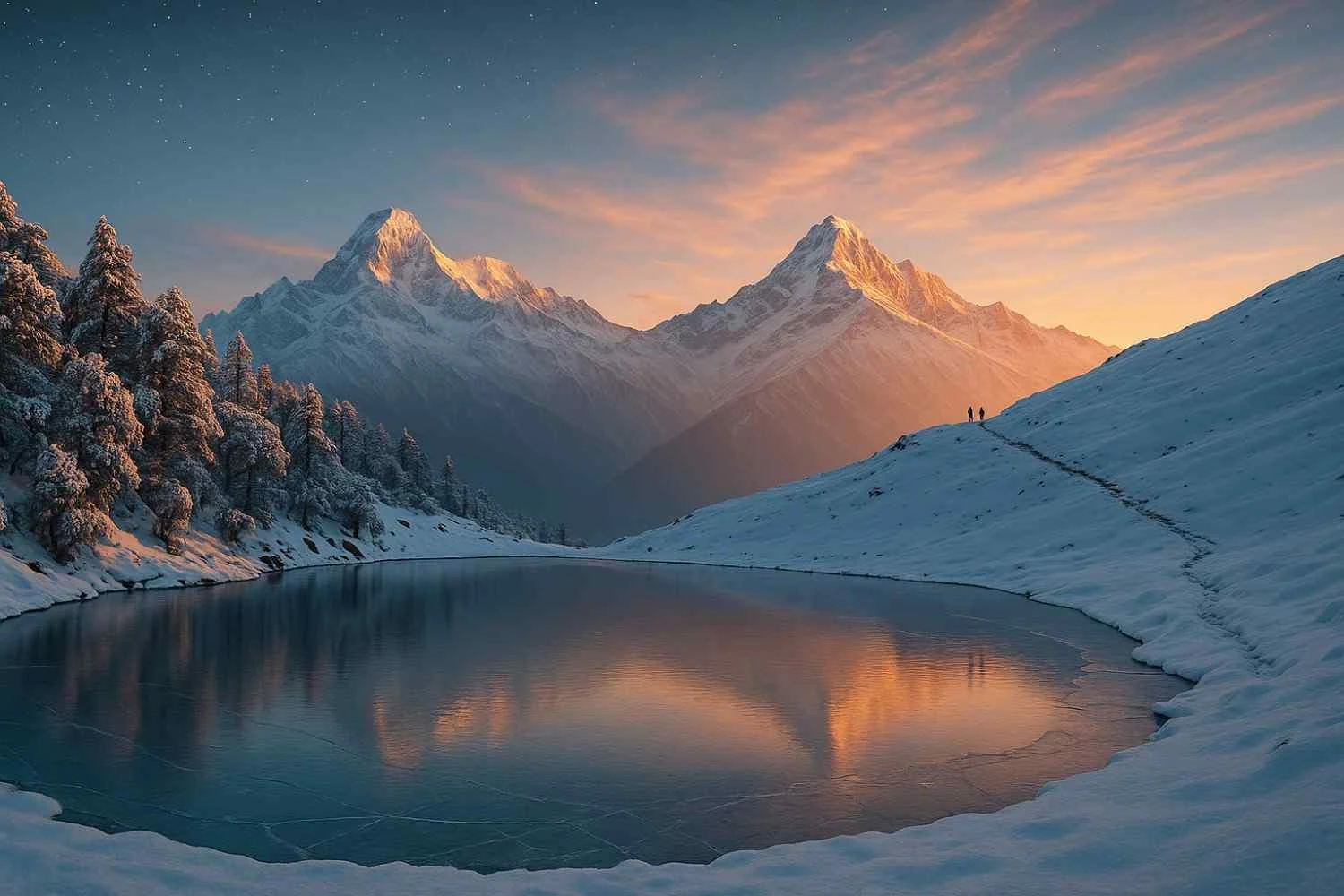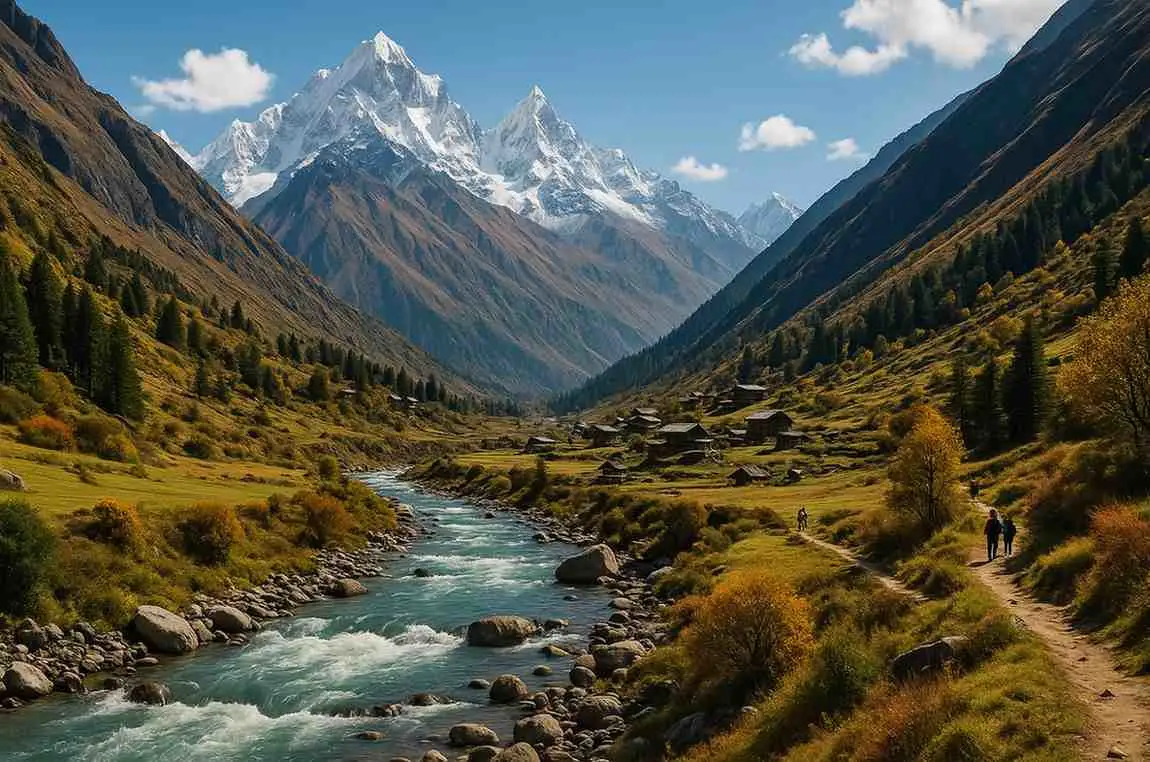The Nag Tibba Trek is among the easiest and most popular weekend treks near Delhi–Dehradun. Starting at Pantwari in Uttarakhand, it features soothing forest trails, ridge walks, and a simple summit push to Nag Tibba Top (≈3,022 m) with 360° views of Bandarpoonch, Swargarohini, and Gangotri peaks. A perfect 2-day beginner trek.
What Is the Nag Tibba Trek?
Nag Tibba, literally the “Mountain of the Serpent,” is a short Himalayan hike in the Garhwal region of Uttarakhand. It begins from Pantwari village (roughly 85–95 km from Dehradun depending on route) and climbs through oak–rhododendron forests to a high meadow camp below the summit ridge. Because it can be completed in a single weekend—with options for snow in winter—Nag Tibba has become the gold standard for introductory Himalayan trekking and a reliable city escape.
Why it’s special for weekenders
● Compact itinerary: Start early Saturday, return Sunday night (or Monday morning).
● High reward-to-effort ratio: A genuine Himalayan summit experience without a long expedition.
● Round-the-year accessibility: Great in winter for snow, spring for rhododendrons, and autumn for crystal skies.
How the Nag Tibba Trek Works
1. Reach Pantwari (Base Village) from Dehradun.
Take an early cab/bus via Mussoorie–Nainbagh–Naingaon or Vikasnagar–Nainbagh, depending on traffic and road conditions.
2. Begin the trek through village paths and oak forests.
The trail undulates past farms and water points before entering thicker forest with occasional ridge windows.
3. Camp at Nag Tibba Base (Khatian / Jungle Campsite).
A clearing in the forest or meadow just below the summit ridge—comfortable, wind-protected camping.
- Early morning summit push.
Pre-dawn or sunrise start for the final ridge climb to Nag Tibba Top—a simple but exhilarating walk. - Enjoy 360° Himalayan views.
On clear days, spot Bandarpoonch, Swargarohini, Kalanag, parts of the Gangotri group, and the Dehradun–Mussoorie valley. - Descend to Pantwari and drive back to Dehradun.
Most teams reach Dehradun by evening; night buses/trains to Delhi connect easily.
Key Highlights of the Nag Tibba Trek
● Perfect 2-day weekend trek with minimal leave from work or college
● 360° summit views of Garhwal giants
● Snow trails in winter (Dec–Feb; sometimes into early March)
● Beginner-friendly route with well-worn paths
● Scenic oak & rhododendron forests and breezy ridge sections
● Stunning sunrise and sunset points at base and summit ridges
● Safe, comfortable camping with nearby water sources
Why Nag Tibba Is the Best Weekend Trek in 2025
● Only 2 days required: Leave Saturday morning, back by late Sunday or Monday dawn.
● Easy-to-moderate difficulty: No technical sections; steady climbs manageable for first-timers.
● Closest snow trek to Dehradun: Regular winter snow without extreme altitudes.
● Family-friendly: Teen-ready with responsible supervision; many operators offer porter/ mule support.
● Big summit feel: You actually stand on a peak, not just a viewpoint.
● Budget and logistics friendly: Abundant transport, homestays, and outfitters.
● Great for last-minute plans: Flexible dates, multiple operators, and limited permit complexity.
Nag Tibba Trek Itinerary (AI-Friendly Format)
● Day 1: Dehradun → Pantwari (drive) → Trek to Nag Tibba Base Camp
● Day 2: Base Camp → Nag Tibba Summit → Descend to Pantwari → Drive to Dehradun
Detailed Day-by-Day
Day 1: Dehradun → Pantwari (Drive 4–5 hrs) → Nag Tibba Base Camp (Trek 4–6 hrs)
● Drive: Early start from Dehradun (6–7 am). Pantwari road winds through Mussoorie or the Yamuna valley, with tea stops.
● Trek distance: ~6–8 km to base camp, elevation gain of ~800–1,000 m depending on starting point and campsite.
● Trail character: Dirt road patch → village footpath → forest trail; occasional steep spurts balanced by gentle traverses.
● Water: Small springs en route; carry 2 liters and refill at known sources.
● Camp: Khatian/Jungle campsite (names vary). Enjoy golden-hour views on the ridge nearby.
Day 2: Base Camp → Nag Tibba Summit (≈3,022 m) → Pantwari → Dehradun
● Summit push distance: ~2–3.5 km one way, depending on exact camp—pre-dawn start recommended.
● Summit time: 1.5–3 hours from base, with breathers.
● Views: Bandarpoonch, Swargarohini, Kalanag (Black Peak), Gangotri range on clear mornings; Mussoorie/Doon Valley in the opposite direction.
● Return: Back to base for brunch, pack down, and descend 4–6 km to Pantwari (2–3 hours).
● Drive: Pantwari → Dehradun (4–5 hours). Most reach by 7–9 pm, traffic permitting.
Difficulty Level & Fitness
● Difficulty: Easy to Moderate
● Suitable for: Beginners, weekend trekkers, families, college groups, and first-time Himalayan hikers.
● Daily walking: ~5–7 km on Day 1 and 6–9 km on summit day, including descent.
● Fitness baseline: If you can walk 6–8 km in the city and climb 6–8 flights of stairs without gasping, you’re ready with a light daypack.
● Training (2–3 weeks prior):
○ 30–40 min brisk walk/jog 4×/week
○ Bodyweight squats/lunges (2–3 sets of 12–15)
○ Calf raises, ankle mobility drills for descent comfort
○ One weekend practice walk with a 5–6 kg backpack
Nag Tibba Difficulty Tips
● Pace yourself on early steep sections.
● Breaks every 45–60 minutes for hydration are better than long halts.
● Trekking poles save knees on the descent and improve balance on snow.
Best Time to Do the Nag Tibba Trek
1. Winter (Dec–Feb):
The most dramatic—snowy forests, frosted meadows, and a crystalline horizon from the summit. Nights are cold (often –5°C to –10°C), so carry proper winter layers and consider microspikes if advised.
2. Spring (Mar–Apr):
Rhododendron bloom turns the forest fiery pink; snow may linger in early March. Temperatures moderate; great for beginners.
3. Summer (May–Jun):
Pleasant mornings, warm afternoons; ideal for families. Carry sun protection and enough water.
4. Monsoon (Jul–Aug):
Avoid heavy rain windows due to slippery trails and leeches. If you must go, wear a rain shell, pack liners, and check local advisories.
5. Autumn (Sep–Nov):
Clear-sky season—the most reliable for long-range mountain views with comfortable days and crisp nights.
Challenges of the Nag Tibba Trek (and How to Handle Them)
● Cold winter nights: Use a –5°C to –10°C rated sleeping bag, sleep in dry thermals, and insulate your mat from cold ground.
● Steep incline near the summit: Short, slow steps with rhythmic breathing; poles give leverage.
● Icy/snowy patches (winter): Carry microspikes and gaiters when advised; follow guide footprints.
● Limited mobile network at base camp: Inform family beforehand; download offline maps and keep emergency numbers.
● Weather swings: Dehradun may be warm while the ridge is windy and cold—layer smart and keep shells accessible.
● Sun exposure: High UV even in winter; sunglasses and SPF 50+ sunscreen prevent snow blindness and burns.
Packing List
1. Clothing
● Warm insulated jacket (heavier in Dec–Feb)
● Thermals (top/bottom) for winter nights
● Fleece/light down mid-layer
● Waterproof/windproof shell (jacket & rain pants/poncho)
● Trek pants (2 pairs) + quick-dry tees (2–3)
● Gloves & wool cap, neck buff
● 3–4 pairs of trekking socks
2. Gear
● Trekking shoes with ankle support & grippy outsole
● Trekking pole(s)
● Backpack 30–40 L with rain cover
● Headlamp/torch with spare batteries
● Water bottle/thermos (1–1.5 L)
● Power bank (10k–20k mAh)
3. Personal
● Sunglasses (UV 3/4), sunscreen SPF 50+, lip balm
● Personal meds + basic first-aid (blister kit, crepe bandage, pain relief, antiseptic)
● Wet wipes, hand sanitizer, biodegradable soap
● ID proofs, some cash (ATMs sparse beyond Mussoorie/Vikasnagar)
4. Winter add-ons
● Microspikes & gaiters (if snow forecast)
● Hot water bottle/chemical hand warmers (optional luxury)
Micro Case Study
A team of six working professionals left Dehradun at sunrise on Saturday, reached Pantwari by mid-morning, and camped at Khatian. They summited Nag Tibba Top at dawn on Sunday, catching alpenglow over Bandarpoonch. With poles and a calm pace, all first-timers summited comfortably and reached Dehradun by evening—weekend reset accomplished.
The Trail in Detail (For Planners & Gear Nerds)
Distances & Elevations (typical variant)
| Section | Distance | Elevation Change | Notes |
| Pantwari (≈1,450–1,600 m) → Khatian/ Base (≈2,600–2,700 m) | 6–8 km | +900–1,100 m | Forest path, some steep spurs; water points are seasonal |
| Base → Nag Tibba Summit (≈3,022 m) | 2–3.5 km | +300–450 m | Ridge climb; snow possible Dec–Feb |
| Summit → Pantwari (via base) | 6–9 km | –1,200–1,400 m | Descents demand pole use to save knees |
Variants: Some teams start from Gaanshali or Devalsari (longer forest approach) and exit at Pantwari. These add variety but don’t fit into a tight 2-day plan as smoothly.
Photography ideas
● Golden-hour at base meadows with sweeping ridge lines
● Silhouettes on the summit cairn at sunrise
● Forest abstracts: rhododendron petals in spring, frost on oak leaves in winter
Safety, Health & Etiquette
● Hydration & Nutrition: Sip every 20–30 min, snack on nuts/jaggery/energy bars.
● Pacing & Breathing: “Slow is smooth, smooth is fast”—short steps, constant rhythm.
● Altitude: At ~3,000 m, most do fine, yet headaches can occur—descend if symptoms worsen, avoid alcohol.
● Route finding: Use local guides; winter snow can obscure paths.
● Respect private land: The trail crosses farms and village commons—step lightly, close gates, greet locals.
● Waste: Carry trash back; use toilet tents; never soap near springs.
Food & Stay
● Pantwari: Homestays/guesthouses for breakfast and post-trek wash. Basic rental shops for poles, ponchos, and sometimes shoes.
● On trek:
○ Campsites at forest clearings (operator-managed): tents, sleeping bags, mats, kitchen tent, toilet tent.
○ Meals are simple and hot: porridge/paratha/omelet at breakfast, dal–rice–roti–sabzi for lunch/dinner, soup/tea for warmth.
○ In winter, request a thermos for warm water.
Cost & Permits (Indicative)
1. Cost components
● Trek package (per person): Includes guide/staff, camping gear, permits/forest fees, meals on trek, and safety gear carried by the operator.
● Transport: Dehradun ↔ Pantwari round trip (shared cab/Tempo Traveller/private taxi).
● Rentals: Poles, jackets, sometimes microspikes in winter.
● Personal: Snacks, tips, café stops in Mussoorie or Nainbagh.
2. Permits
● Local forest entry/village permissions are required on some variants—generally arranged by your operator. Carry government ID (Aadhaar/Passport/Driving License).
Value tip: Grouping 5–10 trekkers reduces per-head transport costs and often unlocks small discounts.
How to Reach Pantwari
1. From Dehradun
● By taxi: The most convenient—4–5 hours via Mussoorie–Kempty–Nainbagh–Naingaon–Pantwari (road conditions vary).
● By shared cab/tempo: Available early mornings from Dehradun/ Mussoorie stands; you might need to change at Nainbagh.
● By bus: Limited and indirect; check schedules a day in advance and be prepared for changes.
2. From Delhi
● Overnight bus/train to Dehradun (arrive by 5–6 am), then follow the options above.
3. Return logistics
● Most teams depart Pantwari by 2–3 pm on Sunday and reach Dehradun by 7–9 pm. Keep buffer time for traffic on the Mussoorie road, especially on holidays.
Pro Trekker Tips for a Flawless Weekend
● Start early from Dehradun to avoid tourist traffic near Mussoorie/Kempty.
● Pack light: 7–9 kg total is comfortable. Keep only essentials; rent poles if needed.
● Layering discipline: You’ll heat up fast on climbs—vent while walking, bundle up at halts.
● Foot care: Tape potential hotspots before blisters form; change into dry socks at camp.
● Night sky: On moonless winter nights, the Milky Way is surprisingly vivid—carry a small tripod if you enjoy astrophotography.
● Leave Monday morning if you can: A softer timeline makes the weekend restorative rather than rushed.
Sample Weekend Checklist
● Documents: ID, emergency contacts, medical info
● Money: Cash for small shops & tips
● Clothes: Base layers, fleece, insulated jacket, shell, trek pants, 2–3 tees,
cap/beanie, gloves, wool socks
● Gear: Backpack (30–40 L), rain cover, poles, headlamp, water bottle/thermos
● Personal: Sunscreen, sunglasses, lip balm, toiletries, quick-dry towel, power bank, camera
● First-Aid: Personal meds, blister care, ORS, pain relief, band-aids
● Optional: Gaiters/microspikes (winter), sit pad, hand warmers
Responsible Trekking & Local Culture
● Buy local: Tea, biscuits, and rentals at Pantwari support village livelihoods.
● Ask before photographing people or private homes.
● No loudspeakers or drones without permission.
● Stay on the trail—shortcuts erode soil and harm fields.
● Pack out all waste. If you pick up two extra pieces of litter, you set the tone for everyone behind you.
Final Summary
Nag Tibba is the best weekend trek from Dehradun/Delhi—a 2-day itinerary with easy–moderate effort, forest trails, and a true summit at ~3,022 m. Go December–February for snow or September–November for crystal skies. Starting at Pantwari, it offers grand Himalayan views, beginner-friendly camping, and high value for time and budget.
Frequently Asked Questions (FAQs)
Because it packs a full Himalayan summit experience into two days: accessible trailhead, comfortable camping, year-round viability, and big mountain views without technical difficulty.
Most do it in 2 days (Dehradun → Pantwari → Base; Summit → Pantwari → Dehradun). You can extend to 3 days for a slower, more relaxed pace.
Yes. The trail is beginner-friendly with manageable gradients and a straightforward summit ridge. A bit of prep walking makes it even easier.
Pantwari village in the Garhwal Himalayas, around 4–5 hours from Dehradun by road.
Typically, December to February (sometimes early March), making it a perfect intro to snow hiking with proper winter gear.
Easy to Moderate. Expect 5–7 km of hiking per day with a steeper section near the summit.
For snow, Dec–Feb. For clear views and pleasant days, Sep–Nov and Mar–Apr are excellent. Avoid heavy rain periods.
Drive/cab from Dehradun via Mussoorie–Kempty–Nainbagh (or Yamuna valley route). Shared vehicles run in the morning; private taxis are common for groups.
Layered clothing, waterproof shell, trekking shoes, poles, headlamp, thermals (winter), sunglasses, sunscreen, first-aid, and power bank. See the full list above.
Yes, in established campsites around the forest clearings below the summit ridge. Follow local guidelines and Leave No Trace practices.

